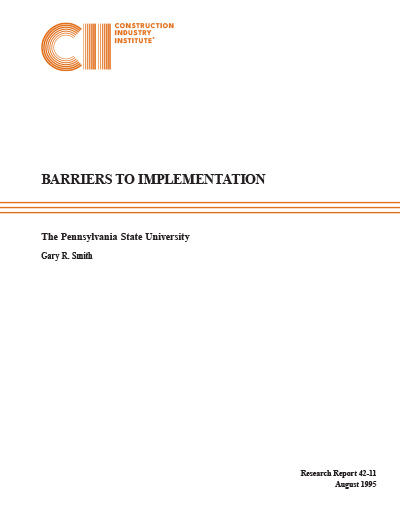
Guidelines for Implementation of CII Concepts: Best Practices for the Construction Industry
Consistent with its mission, CII has embraced several industry concepts which have been defined by its member companies as “best practices” to achieve the most cost-effective construction. These concepts have been upheld as the keys to achieving the goals with which CII has challenged industry:
By the year 2000:
- 20% reduction in cost and schedule
- 25% reduction in accidents
- 20% improvement in productivity
- 95% predictability of cost & schedule
Recent research indicates that these practices are not being implemented to a significant extent on CII member company projects. With such a dramatic potential for savings and improvements, why not? Can it be due to insurmountable barriers?
Barriers do exist. Whether real or perceived, they inhibit or prevent innovation and change and contribute to slow industry progress. Significant, intuitive benefits can be realized from implementation of the CII concepts. CII member companies have devoted many years of research, the results of which have been published as the recommended and necessary improvements for the construction industry. These recommendations for cost-effective construction are embodied in the CII concepts. With increasing competition in world markets can companies or the industry in general afford to disregard these recommendations and accept the status quo?
By recognizing that typical barriers exist along with the opportunities for improvements and cost benefits, companies can begin to overcome the barriers and realize the savings. This is a first step in the improvement process, which can be facilitated by the application of tools, training and integrated procedures addressing the CII recommendations for improved construction cost-effectiveness.
This publication was developed by the Barriers to Implementation Research Team to address the barriers found in industry, which inhibit full application of the “best practice” concepts. The publication incorporates the recommendations from the research and provides useful information, tools, and procedures to help overcome barriers and improve implementation of the concepts.
The Guideline has been structured as a practical reference and tool for understanding, assessing and improving the implementation of 13 core CII concepts as best practices. It is intended for use by construction and project individuals and managers, company management, continuous improvement steering committees, and others interested in improvements and more cost-effective construction projects.
The Guideline provides the opportunity and tools to improve implementation of the CII concepts by:
- Increasing familiarity with the CII concepts.
- Assessing current level of implementation on company projects versus industry average.
- Following detailed checklists for enhanced levels of implementation.
- Using guidelines to incorporate recommendations into company plans and procedures.
- Using the Guideline as a training aid for project individuals and management.
What’s inside...
- Definition of the CII Concepts
- Key Elements for Implementation
- Checklists for Implementation Plans and Procedures
- Listing of Common Barriers
- Implementation Planning Process
- Self-Assessment Tool for Current Implementation Level
- Recommended Implementation Strategies
- Index of CII Publications and Concept Information



